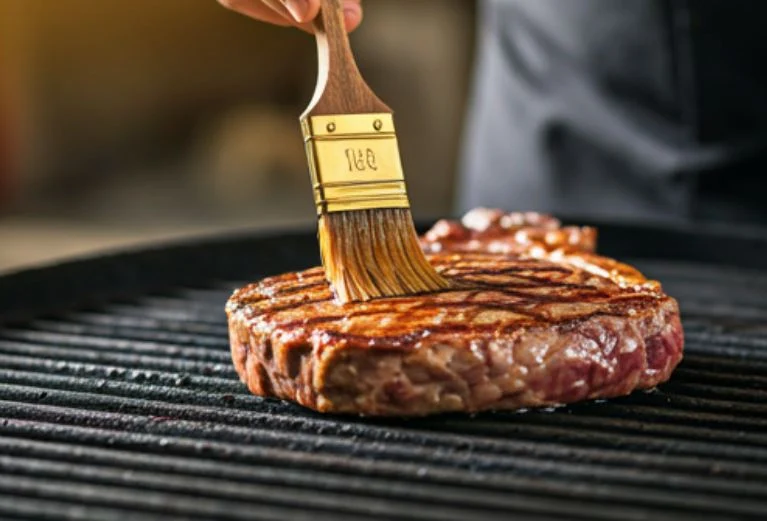If you’ve ever had a beautifully roasted turkey or a perfectly grilled steak that was juicy, tender, and full of flavor, chances are someone took the time to baste it. While it might sound fancy, basting is actually a super simple technique that anyone can master—and it can make a world of difference in your cooking.

So, what exactly is basting? It’s the process of regularly spooning, brushing, or pouring liquids—like pan drippings, melted butter, or marinades—over food as it cooks. This keeps the food moist, adds extra flavor, and helps prevent it from drying out, especially when cooking meats for longer periods.
Why Baste?
You might be wondering, “Do I really need to baste my food?” Well, the short answer is: if you want your food to be juicy and flavorful, basting can help you get there. Here’s why:
Keeps Food Moist: As food cooks, especially in the oven or on the grill, it tends to lose moisture. By adding a layer of liquid over the top, you’re helping to trap moisture inside the food, keeping it juicy and preventing it from drying out.
Enhances Flavor: When you baste with something flavorful—like butter, stock, or a marinade—you’re continuously layering those flavors onto the surface of the food. The result? A richer, more flavorful crust or exterior.
Promotes Even Cooking: Basting also helps food cook more evenly. As you pour or brush liquid over the top, it redistributes the heat and keeps the surface from becoming too dry or overcooked before the inside is fully done.
How to Baste Like a Pro
Now that you know why basting is so helpful, let’s break down the simple steps to baste your food:
Choose Your Basting Liquid: What you use to baste depends on what you’re cooking. For meats, you might use pan drippings, melted butter, or a flavorful marinade. If you’re cooking something like poultry or roast beef, the juices from the meat that collect in the bottom of the pan work beautifully. For grilled items, you might brush on a sauce or butter to add extra flavor.
Baste Early and Often: For most meats, you’ll want to start basting once the surface has started to brown—usually about halfway through the cooking time. Then, you’ll want to repeat the process every 20 to 30 minutes, depending on how long the dish takes to cook. If you’re grilling, basting might be done more frequently since the direct heat dries food out faster.
Use the Right Tools: A long-handled spoon works great if you’re basting from pan drippings, but you can also use a brush for something like butter or a sauce. A bulb baster (those squeezable tubes with a rubber bulb at the top) can help you suck up liquids from the bottom of the pan and squeeze them back over the top of the food.
Don’t Overdo It: While basting is great for adding moisture and flavor, too much of a good thing can actually hinder the cooking process. Constantly opening the oven or grill to baste will release heat and can extend your cooking time. So, make sure you baste often enough to keep things juicy, but not so frequently that it cools everything down.
What Foods Benefit Most from Basting?
Not all foods need to be basted, but there are a few that definitely benefit from this technique:
Poultry: Whole chickens or turkeys can dry out easily, especially when roasted for a long time. Basting with pan juices or butter helps keep the meat moist and flavorful.
Roasts: Large cuts of meat like beef, pork, or lamb roasts can lose moisture during the cooking process. Regular basting ensures they stay juicy and develop a rich, caramelized crust.
Grilled Meats: Whether it’s steaks, pork chops, or ribs, basting with a sauce or butter while grilling adds flavor and keeps the exterior from becoming too dry or tough.
Fish: Whole fish or fish fillets, especially when grilled or broiled, can dry out quickly. Basting with butter or a simple marinade helps keep the fish tender and flaky.
Vegetables: Yes, even vegetables can benefit from a little basting. Roasted root veggies like carrots, sweet potatoes, or squash become extra delicious when basted with olive oil or butter, helping them caramelize and become crispy on the outside.
Basting vs. Brining: What’s the Difference?
If you’ve heard of brining, you might wonder how it differs from basting. While both techniques help keep food moist, they work in different ways:
Basting: This is done while the food is cooking. You’re continuously adding moisture and flavor to the surface of the food throughout the cooking process.
Brining: This is done before cooking. The food (usually meat or poultry) is soaked in a saltwater solution for several hours or overnight. This process helps the meat absorb moisture and flavor from the inside out, ensuring it stays juicy during cooking.
Both techniques are great, but basting is all about adding moisture and flavor as the food cooks, while brining is about prepping the food beforehand to lock in moisture.
Final Thoughts on Basting
Basting might sound like a small step in the cooking process, but it can make a huge difference in the end result. It’s one of those simple, hands-on techniques that elevates your food, turning it from good to wow. Whether you’re roasting a turkey for the holidays, grilling up a steak, or baking a whole fish, taking the time to baste can give you that perfect balance of moisture, flavor, and beautiful browning.
So, next time you’re cooking something that takes a little time, don’t forget to grab a spoon or a brush and start basting. You’ll be surprised at how much better your dish turns out!
Read Next: